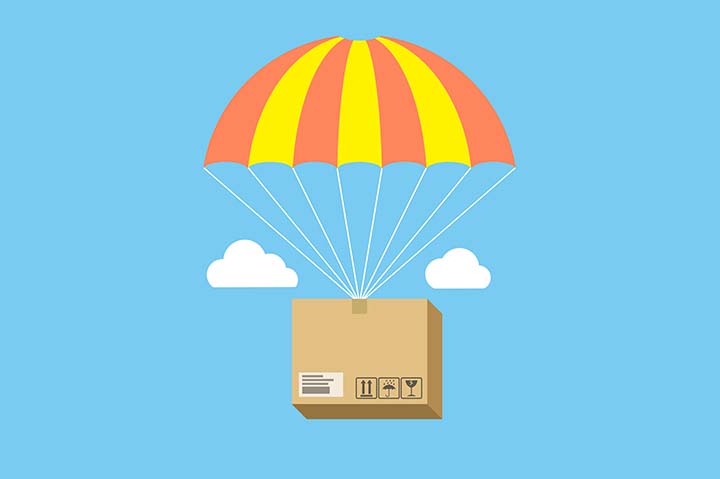Strategy November 17, 2022
Top Tips for a Seamless Drop-Ship Experience
Sending products directly to end-users is an appealing option – as long as you provide the right information.
In this age of Amazon orders and routine online shopping, opening the front door and seeing a package shouldn’t cause too much excitement – but it does! Getting a parcel delivered right to your doorstep, especially if it’s a gift, is still a surprisingly delightful experience.
Drop-ship fulfillment is where it all begins. Drop-shipping is a service whereby suppliers use a carrier to transport an individually boxed promo product or kitted gift directly to end-users’ homes using an address list provided by the client through the distributor.

The distribution practice rose dramatically during the pandemic as a way for companies to deliver gifts directly to remote workers or clients at their homes. Dan Walls, logistics manager at PowerStick.com (asi/51566), estimates that in 2021 approximately 25% of the company’s orders were drop-shipped. This year, he’s seeing only a slight decline in drop-shipping with an equal uptick in bulk shipments. That’s because today, even with many employees having returned to their workplaces at least one or two days a week and in-person events back on the calendar, promotional products drop-shipping continues to be a service in high demand because of its ease, convenience and the personal touch it delivers – especially for holiday and year-end thank-you gifts for clients, employees and vendors. Drop-shipping can also be a profitable add-on service for distributors.
Note that while some suppliers in the promo industry outsource drop-shipping to a third-party fulfillment company, others like PowerStick handle the process of producing the shipping labels, packing the boxes and shipping them out fully in-house using carriers such as FedEx, UPS and USPS. (Or all three, in the case of PowerStick.)
Learning the Basics of Drop-Shipping
Drop-shipping involves three basic steps to transport a package from the factory to the recipient’s doorstep.
- The distributor must provide an Excel spreadsheet containing recipient information which is then carefully checked to make sure all the information has been entered in the correct columns.
- Next, the file is uploaded to the supplier’s shipping software, and any errors found by the system are corrected before printing the shipping labels.
- The boxes are prepared, packed, labeled and shipped.
The success of drop-shipping depends largely on the address list provided to the supplier, so the phrase “garbage in, garbage out” definitely applies here. Drop-ship mistakes can be expensive to rectify. For example, if the spreadsheet the distributor provides contains errors and the recipient details aren’t verified, the package could be deemed “undeliverable” and will be returned to the shipper, not the owner of the account number.
Another aspect to consider is that in some countries, such as Brazil, Argentina and India, it’s virtually impossible to get a package cleared by customs. If it can’t be cleared within a short period of time, 2-3 days in the case of South America, it will be returned. The supplier charges it back to the distributor who, in turn, charges it back to the client. In many countries, the freight company will call ahead to the recipient saying they have a delivery and asking if the recipient will be home to accept it. Unfortunately, the recipient often believes the caller is from a utility company wanting to terminate service so they decline and, after three days, the package is returned to the shipper. All these transactions add up on the shipper’s account and the charges are invoiced back to the distributor and then to the client.
6 Tips to Avoid Errors
To streamline the process, and avoid costly and frustrating delivery errors and delays, distributors must be vigilant in preparing their Excel spreadsheet. These tips will help:
- Verify that the recipients and addresses on the spreadsheet are correct and up-to-date.
- The spreadsheet should contain a separate column for each of these fields: Company Name, Recipient’s Name, Address Line 1, Address Line 2, City, State, Zip, Country, Recipient Phone and Recipient Email. Include first and last name together in a single column. Apartment or suite numbers should go in the Address Line 2 (if applicable), otherwise additional shipping charges will incur.
- Don’t mix quantities of products on a single spreadsheet. In other words, each name on the list should be receiving the exact same shipment. If some recipients are getting a different quantity of products, list them on a separate Excel spreadsheet.
- If shipments are going to recipients in both the U.S. and Canada, create a separate spreadsheet for each country. Recipients in other countries can be included on a single sheet.
- All state and country codes should be in a two-letter format.
- Send the spreadsheet to the supplier as early as possible to allow the necessary time to verify and correct any errors.
As with all business transactions, distributors who want to drop-ship should choose their supplier or fulfillment company wisely, and be aware of the extra challenges for shipments outside of North America. However, if the correct procedures are followed, drop-shipping can be a highly effective delivery method and a profitable part of their business.
Tina Berres Filipski is director of corporate relations at PowerStick.com. She is a 26-year promotional products industry veteran and was previously director of publications and editor at Promotional Products Association International (PPAI).
